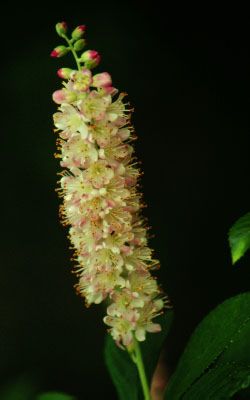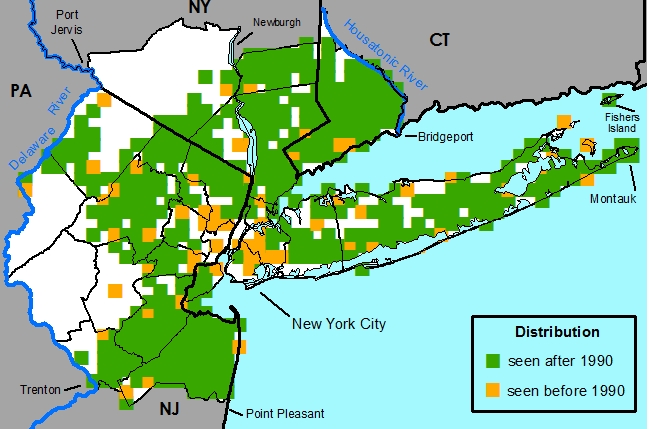Clethra alnifolia L. - Sweet Pepper-Bush
Common Names
Sweet Pepper-BushField Identification
A mid to late summer flowering shrub with alder-like leaves and racemes of small white flowers and persistent, globose capsules.Other uses
Sweet pepper-bush is an important honey plant and is cultivated for this purpose as well as for its ornamental value. Several cultivars are available through nurseries.
Common names
Soap Bush -- The flowers make a soapy lather when rubbed together in water. Stone, however, was not able to demonstrate this with much success.
Spiked Alder
Summer-Sweet
Sweet Pepper-Bush -- The fruits resemble peppercorns but are not hot (i.e., are sweet).
White Alder
Nomenclature
*Clethra alnifolia L., Sp. Pl. 396. 1753. Lectotype: Herb. Linné n. 567 (LINN), selected by (Sleumer, 1967).
*Clethra alnifolia var. denudata Aiton, Hort. Kew. 2: 73. 1789. Type: "Nat. of North America. Introd. 1736, by Peter Collinson, Esq. Coll. mss." (under species name); cultivated material grows at Kew (BM) according to Sleumer (Sleumer, 1967). [leaves glabrous]
*Clethra paniculata Aiton, Hort. Kew. 2: 73. 1789. ¤C. alnifolia var. paniculata (Aiton) G. Nicholson, Kew Hand-List Tr. Shr. 2: 619. 1799. Type: "Nat. of North America: Mr. William Young" (BM). [flowers in a panicle]
¤Clethra dentata Aiton, Hort. Kew. 2: 73. 1789. Type: unknown.
*Clethra alnifolia var. glabella Michx., Fl. Bor.-Amer. 1: 260. 1803. Type: "Hab. [alpha] glabella in Pennsylvania" is based on a specimen "Clethra du New Jersey" (P-Michx) according to Sleumer (Sleumer, 1967). [leaves glabrous]
*Clethra angustifolia Raf., Autikon Bot. 6. 1840., not DC. 1839. Type: Florida. [narrow leaves]
*Clethra pumila Raf., Autikon Bot. 7. 1840. Type: southern New Jersey. [4-10 inches tall, small unifacial leaves]
*Clethra nana Loddiges ex Steudel, Nom. 2, 1: 383. 1841. Type: none cited, for placement here see Sleumer (Sleumer, 1967). [reduced size and compact habit]
¤Clethra alnifolia var. scabra G. Nicholson, Kew Hand-List Tr. Shr. 2: 67. 1896. not Persoon. Type: unknown.
*Clethra alnifolia f. rosea Rehder, Mitt. Deutsch. Dendr. Ges. f. 1907: 75. 1908. Type: United States. Massachusetts: Watuppa Lake, near Fall River, 1906, Louis Holmes Handy (GH). [flowers pink]
Description
HABIT perennial, deciduous, phanerophyte, shrubs, autotrophic, monoclinous, with fibrous roots, 1-3 m tall, not modified.
STEMS erect, round, not winged, "regular". Prickles absent. Bark smooth, not exfoliating, reddish orange or gray. Branches erect or ascending, reddish orange or gray, round, not winged, 2-3 mm in diam. Twigs reddish orange, not odoriferous, round, 2-3 mm in diam., smooth, hairs rotate stellate, appressed, multicellular, white, dense, throughout, glabrescent, without glands. Pith present, white, round, continuous. Thorns absent. Aerial roots absent. Sap translucent. Resin absent.
BUDS terminal and axillary buds dimorphic. Terminal bud present, obovoid, 3.5 mm long, blunt. Axillary buds present, 1, ovoid, 0.5 mm long, blunt. Bud scales 4, white, imbricate, narrowly oblong, coriaceous (?), acute, hairs long and unbranched, appressed, multicellular, uniseriate, gray, dense, throughout, not glabrescent, without glands. Bud scale scars. Leaf scars obdeltate, 0.6-1.2 mm high, 0.5-1 mm wide. Vascular bundle scars 1, circular, 0.3-0.5 mm tall, forming a short peg.
LEAVES alternate, 1 per node, crowded toward stem apex (?), divergent from stem, simple. Stipules absent. Leaves petiolate, petiole "typical", 0.5-1.2 cm long, hairs long and unbranched and hairs rotate stellate, appressed (both types), multicellular (both types), uniseriate (long unbranched hairs), moderately dense or dense, throughout, glabrescent (?), without glands. Leaf: abaxial surface green, adaxial surface green, blades oblanceolate or ovate or obovate, plane, symmetric, (3-)4-12 cm long, 2-6.5 cm wide, chartaceous, base cuneate, margin sharply serrate, apex acute, abaxial surface hairs long and unbranched, appressed, multicellular, uniseriate, white, sparse, along midveins (and other veins), not glabrescent, without glands, adaxial surface hairs rotate stellate, appressed, multicellular, white, sparse, along midveins, glabrescent, without glands. Simple craspedodromous venation, veins 16-18 (8-9 per side). Leaf lobes absent. Spines absent. Tendrils absent.
INFLORESCENCES monomorphic, regular or, if dimorphic, female inflorescence simple, raceme (rarely paniculately branching), terminal. Peduncle present, 1.5-2 cm long. Rachis present, 2.5-12.5 cm long, with bracts. Bracts sessile, blades: abaxial surface orange-red, adaxial surface orange-red, linear or linear triangular or lanceolate or narrowly triangular, conduplicate-involute, 3-4 mm long, 0.3-1 mm wide, base truncate or obtuse, margin ciliate, apex acuminate, abaxial surface hairs long and unbranched or hairs rotate stellate, abaxial hairs appressed, multicellular, multiseriate, white, dense, throughout, not glabrescent, without glands, adaxial surface hairs long and unbranched or hairs rotate stellate, appressed, multicellular, uniseriate, white, moderately dense, throughout, not glabrescent, without glands. Pedicel 1.1-3.5 mm long, hairs rotate stellate, hairs appressed, multicellular, white, dense, throughout, not glabrescent, without glands. Bracteoles 2, sessile, at base of pedicel, bracteoles: abaxial surface gray, bracteole: adaxial surface gray, lanceolate, plane, 0.3-0.5 mm long, 0.1 mm wide, base truncate, margin entire, apex acute, very small and early deciduous. Cupules absent.
FLOWERS serotinous, formed on long shoots, monomorphic, with sepals and petals readily distinguishable from one another, bisexual. Perfect or female flowers white, 5 merous, 0.8-1 mm long, 0.5-0.8 mm wide, 17-100 flowers per inflorescence, fragrance present, perianth of two whorls. Calyx present, actinomorphic, campanulate, of free sepals, persistent, abaxial and adaxial surfaces the same color, reddish orange, 2.5-4 mm long, 2.5-4 mm wide. Sepals or sepal lobes 5, narrow oblong or oblong, 2.5-4 mm long, 1.1-1.2 mm wide, base truncate, margin ciliate, apex acute, abaxial surface hairs long and unbranched and hairs rotate stellate, appressed, multicellular, uniseriate, gray, dense, throughout, not glabrescent, without glands, adaxial surface hairs short and unbranched, spreading, unicellular, gray, moderately dense, apically, not glabrescent, without glands. Epicalyx absent. Corolla present, actinomorphic, of fused petals, persistent, abaxial and adaxial surfaces the same color, white, 2.5-5 mm long, 2.5-4(-6) mm wide. Petals or petal lobes 5, "normal", oblanceolate or narrow oblong, 5-5.5 mm long, 1.6-2.1 mm wide, base cuneate, margin entire, apex obtuse, abaxial surface glabrous, without glands, adaxial surface glabrous, without glands. Gynoecium syncarpous. Carpels 3. Stigmas 3, capitate. Styles not persistent, 1, 8-12 mm long, forming 3 branches above, with long, multicellular, uniseriate hairs below. Ovary superior, 1.5 mm long, 1.5 mm wide, nectiferous disk present. Locules 3. Androecium obdiplostemonous. Stamens 10, 5.1-6 mm long. Anthers obcordate, opening by pores, opening 1/4 of entire anther, bithecal, red, glabrous, Filaments free, straight, white, glabrous. Staminodes absent.
FRUITS loculicidal capsule, gray, globose, 1.8-2.8 mm long, 2.2-3.4 mm wide, hairs short and unbranched or hairs long and unbranched, appressed, unicellular or multicellular, uniseriate, gray, moderately dense to dense, throughout (long hairs toward apex), not glabrescent, without glands.
SEEDS many, yellowish orange, oblong, 0.8-1.1 mm long, 0.6-0.9 mm wide, wingless, not tailed, reticulate-foveate.
Habitat
(Reschke, 1990) (Wherry, 1920)
Wet woods, swamps, thickets, marshes, swales and bogs; lake shores, stream edges, and rocks in water. Pine barrens shrub swamp, coastal plain poor fen, red maple-hardwood swamp, inland Atlantic white cedar swamp, and coastal plain atlantic white cedar swamp. It grows in wet sphagnum peat and occasionally dry upland peat at swamp margins; optimal soil is very acidic (pH ca. 4.5).
Rarity Status
Heritage global rank -- G5
Connecticut -- not listed
New Jersey -- not listed
New York -- not listed
Species Biology
Flowering
June [week 2] - Sep [week 3].
Pollination
(Hemingson, 1986)Melittophily -- Flowers are visited by over 100 insects. The most common visitors are Apis mellifera L., Bombus impatiens Cr., and Cantharis nigricans LeConte (a beetle); the last is probably not a pollinator.
Fruiting
Aug [week 3] - Nov [week 4] (persistent until June [week 4]).
Dispersal
(Sleumer, 1967)Anemochory -- Probably wind.
Germination
(Young & Young, 1992)Germinable.

